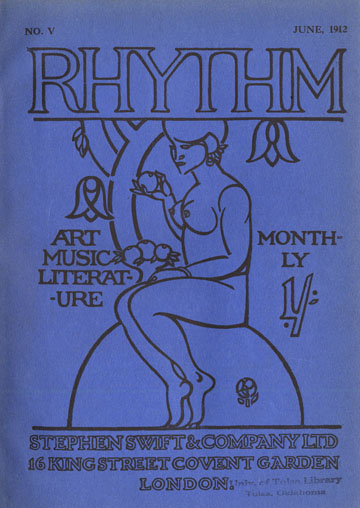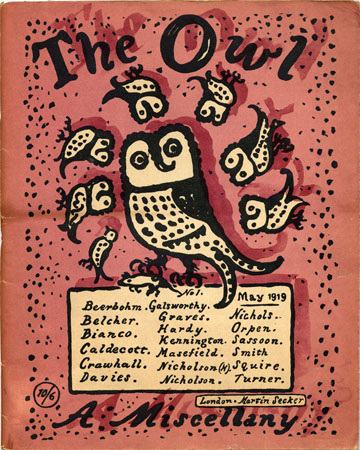
|
April 19, 2007 |
National Endowment for the Humanities
Modernist Journals Project Has Grant to Digitize Rare Magazines
The Modernist Journals Project, a joint effort by Brown University and the University of Tulsa, has been awarded a $332,823 grant from the National Endowment for the Humanities to expand its digital archive of rare periodicals. | |||
|
Brown University Home |
The MJP was launched at Brown in 1995 as a Web site of digitized periodicals connected to the rise of modernism in the English-speaking world from 1890 to 1922. The site includes searchable editions of seven modernist journals: The New Age (1907–1922), Dana (1904-1905), Rhythm (1911-13), Blast (1914-15), The Owl (1915-1923), The Blue Review (1913), and The Tyro (1921-1922). The MJP also features digitized publications of books, biographical sketches of more than 1,000 artists, images of their work, and a database of nearly 600 English language periodicals that operated in this period. The digital archive, managed by the Center for Digital Initiatives in the University’s library, receives approximately 10,000 visits per day. “Modernism began in the magazines,” begins the MJP grant proposal. “It happened in other places as well, including books and art and galleries and concert halls, but magazines provided a combination of new works, manifestos, and critical discussions that were crucial to public acceptance of the new modes of literature and art.” However, the study of modernism through periodicals is somewhat hampered, due to “the deplorable state of the archive that fuels it,” said Robert Scholes, director of the MJP at Brown. He explained that complete runs of these magazines are scarce and scattered in a few libraries around the world. Moreover, even those runs are incomplete due to a frequent practice among libraries of stripping advertising from the pages of the periodicals before binding them into volumes. “No account of modernism and its place within the larger print culture of modernity is complete without attention to magazine advertising,” Scholes said. 
“If we are going to study and teach modernism and its cultural contexts as they emerge through the magazines, we will need access to them all – the little magazines and the larger ones – and to all of them – the advertising as well as the articles,” Scholes said. “It is to this purpose that the MJP is devoted: to digitize as much of the periodical culture, advertisements and all, of the early modernist period as possible, thus filling the hole in the archive.” Under the NEH grant, Brown will receive $168,430 and Tulsa $164,393 over a two-year period to add to the archive digital editions of the English Review, as edited in London by Ford Madox Ford from 1908 to 1910; Poetry: a Magazine of Verse from its founding in Chicago in 1912 to 1922; and Scribner's Magazine of New York for the period 1910 to 1922. For this project, the Princeton University Library is making available its collection of original issues of Scribner's, with all advertising included, and the University of Chicago is providing original issues of Poetry, supplemented, as necessary, by copies from Tulsa’s McFarlin Library. The digital edition of The English Review will be based on issues owned by the MJP, supplemented by issues from Tulsa and Princeton. “We believe this represents a new level of interinstitutional cooperation that will be a model for the effort required to fill the hole in the archive,” said Scholes. Clifford Wulfman, technical director of the MJP and manager of the site at Brown, explained that the work of the MJP has become even more critical with recent advances in mass digitization of printed materials. “The advent of powerful robotic page scanners and the initiatives of large-scale projects like Google Books and the Open Content Alliance promise to augment the digital archive in ways that were unthinkable only a few years ago,” said Wulfman. “While that work is invaluable, the very scale of these digitization juggernauts means they will pass over the rare and sometimes fragile materials that are held in special collections. Highly focused, scholar-driven projects like the MJP play a very important role by identifying and digitizing material that would otherwise be missed.” This is the second grant the Modernist Journals Project has received from the NEH. The MJP received $137,749 in 2003 to complete its first major project: a digital edition of a London weekly magazine, The New Age, that helped to shape modernism in literature and the arts from 1907 to 1922 under the direction of its editor A.R. Orage. The University of Tulsa joined the MJP at the end of that grant period. The National Endowment for the Humanities is an independent grant-making agency of the United States government dedicated to supporting research, education, preservation, and public programs in the humanities. For more information about the Modern Journals Project, visit modjourn.org. Editors: Brown University has a fiber link television studio available for domestic and international live and taped interviews, and maintains an ISDN line for radio interviews. For more information, call (401) 863-2476. ###### | |||
 PROVIDENCE, R.I. — The
Modernist Journals Project (MJP), a joint effort of Brown and the University of
Tulsa, has been awarded a grant of $332,823 from the National Endowment for the
Humanities (NEH) to expand its work of digitizing rare periodicals.
PROVIDENCE, R.I. — The
Modernist Journals Project (MJP), a joint effort of Brown and the University of
Tulsa, has been awarded a grant of $332,823 from the National Endowment for the
Humanities (NEH) to expand its work of digitizing rare periodicals.